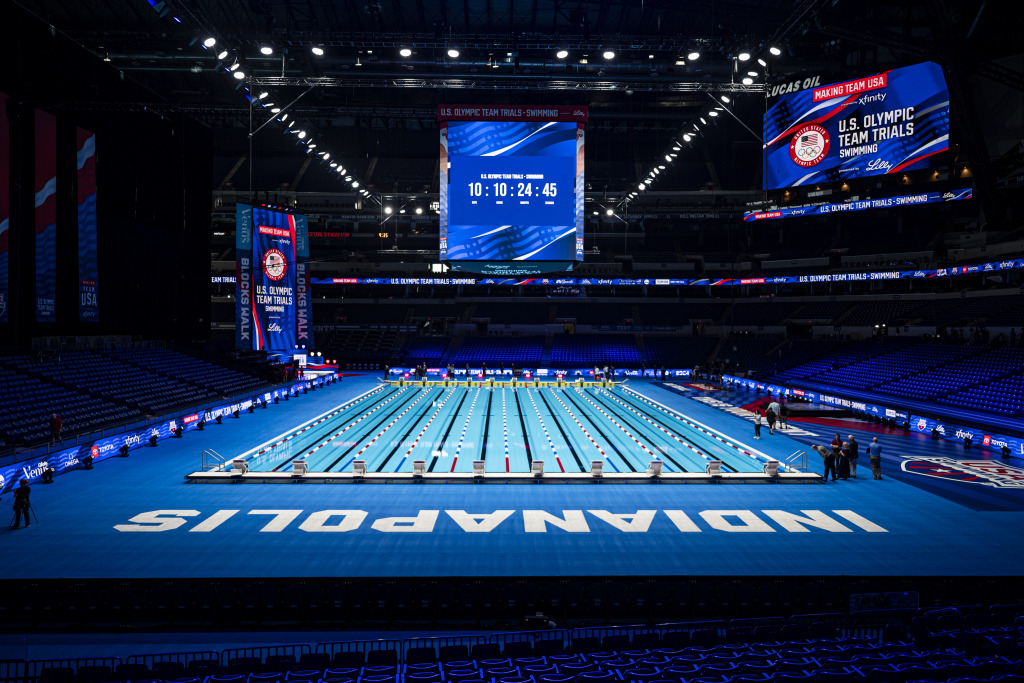Subscriber Benefit
As a subscriber you can listen to articles at work, in the car, or while you work out. Subscribe NowThe main swimming pool for the Paris Olympics is set up inside a 30,000-seat rugby stadium on the city’s western edge.
Sound strange?
Not really. It’s the new norm.
The biggest swim meets are being held in massive venues, which could provide a boost to the sport’s popularity in non-0lympic years.
“I love the idea of more and more people watching swimming,” said Australian star Bronte Campbell, who will be competing in her fourth Summer Games. “The bigger the crowds, the better. Maybe they’ll make enough noise that we can finally hear them underwater.”
The U.S. Olympic trials were held this year at Lucas Oil Stadium in Indianapolis, a 63,000-seat venue that is normally the home of the NFL’s Indianapolis Colts.
The event broke numerous attendance records, drawing 285,202 fans over nine days—including 22,209 for one session.
“I think it was great,” American Nic Fink said. “It was a big swing from USA Swimming to try to host an even like that in Lucas Oil. From my standpoint, it seemed like it was a success in that viewership was up, tickets were good.”
Just as important, it was a meet that appeared to grow the sport beyond its hard-core fan base.
“It seemed like it was a great environment for not only the swimmers and swim fans, who want to go see the best swimming, but also for the casual fans who are like, ‘Oh, the Olympic trials are here, let’s go see what that’s about,’” Fink said.
“I was going into it kind of anticipating it being like a circus, and it was in that regard. But it seemed like a lot of fun. too,” he added. “I think that’s a good introduction and stepping stone to maybe the future of swimming.”
Paris built a new 6,000-seat aquatics center for these Games, but it will be used only for diving, artistic swimming and water polo preliminary games.
The swimming will be held in a temporary pool at La Défense Arena, an indoor stadium that is home of the storied Racing 92 rugby team and has been the venue for major concert tours such as The Rolling Stones, Taylor Swift and Paul McCartney.
The pool is set up at one end of the arena, with a warm-up pool located behind a curtain dividing the facility in half and leaving the capacity for the games at just over 15,000.
“The idea of being able to drop in and have a bigger fan base for the sport is really exciting,” said Australia’s Zac Stubblety-Cook, the reigning Olympic champion in the men’s 200-meter breaststroke. “Going into this arena, even the pool deck space, is really, really incredible. Being able to walk around and having space is actually a small detail but something that everyone has noticed.”
The next Summer Games, at Los Angeles in 2028, will look to make an even bigger splash.
After initially planning to construct a temporary aquatics stadium on the baseball field at the University of Southern California, LA organizers recently announced a series of venue changes that included moving the swimming competition to a portable pool at 70,000-seat SoFi Stadium, the dazzling home to a pair of NFL teams, the Rams and Chargers.
The planned setup will have a capacity of 38,000 seats—by far the largest swimming venue in Olympic history.
“Hopefully, we can carry that momentum of viewership, of getting people involved, casual swimmers, memberships, stuff like that, into a home Olympic games, which will probably be an even bigger circus and more fun,” Fink said.
Portable pools have created far more flexibility in the selection of swimming venues for major meets.
Over the past two decades, several world championships were held in large, multipurpose arenas that were built for sports such as basketball and tennis.
The U.S. trials were held in a temporary facility for the first time in 2004, when an outdoor stadium was constructed in the parking lot outside Long Beach Arena. Then, three straight trials were held at a 17,000-seat arena in Omaha, Nebraska, allowing more fans to attend.
The Indy trials took the event to an even higher level.
The Australians, who are the leading rivals to the powerhouse American squad, took note of the enormous facility and large crowds for the U.S. trials. Head coach Rohan Taylor hopes that his country will some day be able to emulate that Down Under.
“To do it for a trials or a domestic competition, it would be about finding the right facility for a drop-in pool and in a city that would probably come out and support the sport,” he said. “That’s one thing we’ve got to be better at, growing the kind of broader support of it.”
Taylor said it’s also important to focus on bolstering the sport at the grassroots level. The big arenas are certainly eye-opening, but swimming also needs more permanent, year-round facilities, which he described as a goal leading up to the 2032 Summer Games in Brisbane.
But, for now, he’s relishing the big stage in Paris.
“Walking into this facility is incredible,” Taylor said. “Seeing it full will be incredible.”
Please enable JavaScript to view this content.

